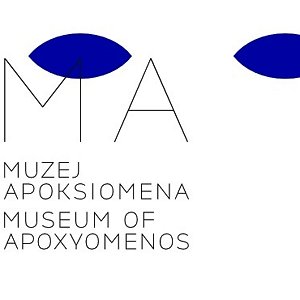
Museum of Apoxyomenos
The Museum of Apoxyomenos is a unique archaeological and architectural cultural institution in our region and it is entirely dedicated to only one exhibit – the bronze statue of a young athlete, the Apoxyomenos. The statue was discovered in 1997 by a Belgian tourist at the depth of 45 m. In 1999, it was taken out of the sea where it spent nearly two millennia. The antique statue of Apoxyomenos embodies a 192 cm tall young athlete scraping off the oil, dust and sweat from his body after a match or an exercise (apoxyómenos = "the one who scrapes off"). The statue was made of bronze and out of the eight Apoxyomenos statues found so far, it is the best preserved one. In his right hand he is holding a sickle-shaped scraper to clean the dust and sweat off his body. It was most likely made according to the Daippos' prototype, the son of the most famous Greek sculptor Lysippos, during the mid-4th century before Christ. The organic material stored by generations of rodents inside the statue shows that Apoxyomenos laid discarded on land prior to setting off towards an unknown destination during the mid-2nd century, possibly Osor. Apoxyomenos is one of the best preserved bronze statues of the ancient times. During the recent years, it has become a symbol of the Croatian statue heritage and the capacity of the restoration profession. The Museum of Apoxyomenos tells the original story of an athlete of perfect physical proportions, a piece of art that is impressive in its wholeness and beauty of composition. The bronze statue of Apoxyomenos dates to either 2nd or 1st c. B.C., and its name stems from Greek term for an athlete that is cleaning his body from oil, sweat, and sand after exercise or competition. The Lošinj athlete depicts the moment when he's cleaning his scraper. The statue is entirely preserved, only missing a little finger of the left hand, eyes, and the scraper, while the right foot was still attached to the original bronze base. Following its removal from the sea bed, the conservation and restoration works on the statue were entrusted to the Croatian Restoration Institute in Zagreb and lasted 6 years, after which the statue was exhibited in some of the most important museums around the world (Louvre, British Museum, J.P Getty Museum). The Museum of Apoxyomenos, exhibiting only one artifact, the unique archaeological find on the Adriatic and its story, was opened in May 2016 in the Kvarner Palace, in the very centre of Mali Lošinj. This beautiful antique sculpture has become Lošinj's symbol and trademark, after nearly 20 years from the discovery and to his return to the Museum created especially for him. The Apoxyomenos' timeless beauty, his unusual and mysterious story, and a distinctive museum setting haven't left anyone unimpressed! The antique statue of Apoxyomenos embodies a 192 cm tall young athlete scraping off the oil, dust and sweat from his body after a match or an exercise (apoxyómenos = “the one who scrapes off”). The statue was made of bronze and out of the eight Apoxyomenos statues found so far, it is the best preserved one. In his right hand he is holding a sickle-shaped scraper to clean the dust and sweat off his body. It was most likely made according to the Daippos’ prototype, the son of the most famous Greek sculptor Lysippos, during the mid-4th century before Christ. The organic material stored by generations of rodents inside the statue shows that Apoxyomenos laid discarded on land prior to setting off towards an unknown destination during the mid-2nd century, possibly Osor. Apoxyomenos is one of the best preserved bronze statues of the ancient times. During the recent years, it has become a symbol of the Croatian statue heritage and the capacity of the restoration profession.









